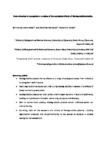From microbes to ecosystems: a review of the ecological effects of biodegradable plastics
| dc.contributor.author | Courtene-Jones, Winnie | |
| dc.contributor.author | Martínez Rodríguez, A | |
| dc.contributor.author | Handy, Richard | |
| dc.date.accessioned | 2022-11-07T16:21:34Z | |
| dc.date.issued | 2022-09-07 | |
| dc.identifier.issn | 2397-8554 | |
| dc.identifier.issn | 2397-8562 | |
| dc.identifier.other | ETLS20220015 | |
| dc.identifier.uri | http://hdl.handle.net/10026.1/19916 | |
| dc.description.abstract |
<jats:p>Biodegradable plastics have been proposed as a potential solution to plastic pollution, as they can be biodegraded into their elemental components by microbial action. However, the degradation rate of biodegradable plastics is highly variable across environments, leading to the potential for accumulation of plastic particles, chemical co-contaminants and/or degradation products. This paper reviews the toxicological effects of biodegradable plastics on species and ecosystems, and contextualises these impacts with those previously reported for conventional polymers. While the impacts of biodegradable plastics and their co-contaminants across levels of biological organisation are poorly researched compared with conventional plastics, evidence suggests that individual-level effects could be broadly similar. Where differences in the associated toxicity may arise is due to the chemical structure of biodegradable polymers which should facilitate enzymatic depolymerisation and the utilisation of the polymer carbon by the microbial community. The input of carbon can alter microbial composition, causing an enrichment of carbon-degrading bacteria and fungi, which can have wider implications for carbon and nitrogen dynamics. Furthermore, there is the potential for toxic degradation products to form during biodegradation, however understanding the environmental concentration and effects of degradation products are lacking. As global production of biodegradable polymers continues to increase, further evaluation of their ecotoxicological effects on organisms and ecosystem function are required.</jats:p> | |
| dc.format.extent | 423-433 | |
| dc.format.medium | ||
| dc.language | en | |
| dc.language.iso | eng | |
| dc.publisher | Portland Press | |
| dc.subject | biological impact | |
| dc.subject | degradation products | |
| dc.subject | ecotoxicology | |
| dc.subject | microplastic | |
| dc.subject | toxicology | |
| dc.subject | Biodegradable Plastics | |
| dc.subject | Ecosystem | |
| dc.subject | Biodegradation, Environmental | |
| dc.subject | Polymers | |
| dc.subject | Carbon | |
| dc.title | From microbes to ecosystems: a review of the ecological effects of biodegradable plastics | |
| dc.type | journal-article | |
| dc.type | Review | |
| dc.type | Journal Article | |
| dc.type | Research Support, Non-U.S. Gov't | |
| plymouth.author-url | https://www.ncbi.nlm.nih.gov/pubmed/36069649 | |
| plymouth.issue | 4 | |
| plymouth.volume | 6 | |
| plymouth.publication-status | Published | |
| plymouth.journal | Emerging Topics in Life Sciences | |
| dc.identifier.doi | 10.1042/etls20220015 | |
| plymouth.organisational-group | /Plymouth | |
| plymouth.organisational-group | /Plymouth/Faculty of Science and Engineering | |
| plymouth.organisational-group | /Plymouth/Faculty of Science and Engineering/School of Biological and Marine Sciences | |
| plymouth.organisational-group | /Plymouth/REF 2021 Researchers by UoA | |
| plymouth.organisational-group | /Plymouth/REF 2021 Researchers by UoA/UoA06 Agriculture, Veterinary and Food Science | |
| plymouth.organisational-group | /Plymouth/Research Groups | |
| plymouth.organisational-group | /Plymouth/Research Groups/Marine Institute | |
| plymouth.organisational-group | /Plymouth/Users by role | |
| plymouth.organisational-group | /Plymouth/Users by role/Academics | |
| dc.publisher.place | England | |
| dcterms.dateAccepted | 2022-08-23 | |
| dc.rights.embargodate | 2023-9-7 | |
| dc.identifier.eissn | 2397-8562 | |
| dc.rights.embargoperiod | Not known | |
| rioxxterms.versionofrecord | 10.1042/etls20220015 | |
| rioxxterms.licenseref.uri | http://www.rioxx.net/licenses/all-rights-reserved | |
| rioxxterms.licenseref.startdate | 2022-09-07 | |
| rioxxterms.type | Journal Article/Review |


